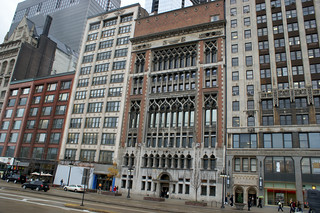Ten large US cities join major new initiative to reduce carbon pollution from buildings

Posted February 21, 2014 at 1:27PM
On January 29, mayors from ten major American cities announced that they will participate in a united effort to significantly boost energy efficiency in their buildings. Combined, the initiative could cut as much carbon pollution as generated by 1 million to 1.5 million passenger vehicles every year, and lower energy bills by nearly $1 billion annually, according to a press release from the Institute for Market Transformation and my colleagues at the Natural Resources Defense Council.
The mayors will be participating in the new City Energy Project (CEP), an initiative conceived by NRDC and IMT that is designed to create healthier, more prosperous American cities by targeting buildings, a major source of energy use and climate pollution. The ten participating cities are Atlanta, Boston, Chicago, Denver, Houston, Kansas City, Los Angeles, Orlando, Philadelphia and Salt Lake City.
Funded by a partnership with Bloomberg Philanthropies, the Doris Duke Charitable Foundation, and The Kresge Foundation, the City Energy Project will help the 10 cities craft their own customized plans for boosting energy efficiency in their buildings.
 Opportunities to reduce energy consumption in our offices, schools, malls, apartments, and other buildings are abundant but largely untapped, despite the potential for enormous benefits. In 2012, buildings were responsible for approximately 40 percent of total US energy usage and carbon pollution. America’s annual utility bill is roughly $450 billion, and each year we use nearly twice the energy consumed in all of South America just to power our buildings.
Opportunities to reduce energy consumption in our offices, schools, malls, apartments, and other buildings are abundant but largely untapped, despite the potential for enormous benefits. In 2012, buildings were responsible for approximately 40 percent of total US energy usage and carbon pollution. America’s annual utility bill is roughly $450 billion, and each year we use nearly twice the energy consumed in all of South America just to power our buildings.
Employing cost-effective strategies to cut the energy use of existing buildings by only 20 percent would put more than $80 billion back into the pockets of businesses and families. Most American buildings were constructed decades ago — before modern energy efficiency codes were implemented — and will continue to be used for generations. By reinvesting in our existing buildings today with low-cost measures to save energy, we can invest in our future.
Our cities are up to the challenge. Innovative policies in several of America’s largest cities are shepherding in a new era of energy awareness and improvement. Simple yet powerful, these policies are helping building operators and businesses uncover major energy savings while unlocking market-driven demand for energy-efficient products and skilled workers. Furthermore, these actions are delivering benefits without additional public subsidies or tax dollars, proving that energy efficiency, economic development, and fiscal responsibility can go hand in hand.
“City skylines have long been symbols of aspiration and innovation. This project takes that to a new level,” according to Laurie Kerr, Director of the City Energy Project at NRDC. “These mayors are showing there is the political will to put people to work to build a healthier, more prosperous future for America’s cities. In the face of a changing climate and increasingly extreme weather, these city leaders know they cannot wait for the state or federal government to make them more resilient and sustainable – they are taking action now.”
The CEP is projected to cut a combined total of 5 million to 7 million tons of carbon emissions annually. That is equivalent to taking 1 million to 1.5 million passenger vehicles off the road or taking three or four power plants offline.
 The Project also will bring significant economic benefits. These include creating jobs in a range of fields and skill levels from electricians to architects, construction workers to engineers, and building technicians to software providers. Increased energy efficiency will also raise property values, as efficient buildings are in great demand. And the effort will lower energy bills for residents and businesses, reducing the cost of living and doing business, and freeing up money that can flow back into local economies. My colleague David Goldstein has estimated that energy efficiency measures (including but not limited to building efficiency) could obviate as much as 30 percent of the energy America will otherwise need over the next 20 years.
The Project also will bring significant economic benefits. These include creating jobs in a range of fields and skill levels from electricians to architects, construction workers to engineers, and building technicians to software providers. Increased energy efficiency will also raise property values, as efficient buildings are in great demand. And the effort will lower energy bills for residents and businesses, reducing the cost of living and doing business, and freeing up money that can flow back into local economies. My colleague David Goldstein has estimated that energy efficiency measures (including but not limited to building efficiency) could obviate as much as 30 percent of the energy America will otherwise need over the next 20 years.
The Project is also estimated by its sponsors to save ratepayers a combined total of nearly $1 billion annually on their energy bills (at current prices).
“Building energy efficiency has far-reaching benefits, not only for the environment, but also in enabling high performing work space, facilitating jobs, and resulting in better financial return,” said Kyung-Ah Park, Head of Environmental Markets Group at Goldman Sachs.”
Many building owners hesitate to invest in energy efficiency due to longstanding market barriers, including limited information, misaligned energy efficiency incentives, and a lack of available capital. At the City Energy Project’s core is a powerful set of strategies designed to overcome these obstacles and clear the way for vastly increased market activity that will improve building energy performance. The key to success is weaving individual energy efficiency strategies together, creating an integrated framework of policies and programs that becomes more than the sum of its parts.
No two cities are the same, and the Project will work collaboratively with each selected municipality to develop and implement solutions that maximize local opportunities and respond to local challenges. The City Energy Project focuses on large buildings because of their greater impacts, and it includes a balance of mandates and supporting programs in four main categories:
- Information and transparency: These measures help building owners and operators understand energy efficiency opportunities and
 enable information about building energy performance to flow freely in the market. Examples include energy benchmarking, performance reporting and disclosure, tenant submetering, and energy audits.
enable information about building energy performance to flow freely in the market. Examples include energy benchmarking, performance reporting and disclosure, tenant submetering, and energy audits. - Raising the baseline: These measures create simple and achievable targets for building operations and maintenance. Examples include retro-commissioning (building system “tune-ups”), lighting efficiency standards, and certifications for building operators.
- Market investment: These measures remove obstacles to investing in energy improvements. Examples include retrofit financing programs and lease provisions that align energy efficiency benefits for owners and tenants.
- Leading by example: Cities will address their own buildings portfolios, and encourage the private sector to match their efforts. Examples include energy reduction commitments and energy efficiency challenge and recognition programs.
A recent analysis by the U.S. Environmental Protection Agency of approximately 35,000 benchmarked buildings across the nation found they reduced energy consumption by an average of 7 percent over a three-year period. The practice is analogous to transparency rules in other market sectors, such as nutritional labels on foods and fuel economy ratings on vehicles, that are recognized around the world as keystones of free and fair enterprise.
“With US buildings consuming more primary energy than entire countries like Russia and India, the scale of the opportunity to optimize building energy performance is significant,” said John Mandyck, Chief Sustainability Officer of UTC Building & Industrial Systems. “Cities collaborating and implementing creative, practical energy efficiency polices can go a long way to reducing America’s $450 billion annual energy bill and carbon emissions.”
Related posts:
- Retrofitting inner-city neighborhoods for energy efficiency (October 1, 2012)
- New, comprehensive database launches to help improve energy efficiency of buildings (March 11, 2011)
- Households in transit-oriented locations save more energy and emissions than even 'green' households in sprawl (February 24, 2011)
- Long Island municipality fights back to save energy retrofits (August 10, 2010)
- Energy efficiency (including smart growth) is essential to economic recovery (July 7, 2010)
Move your cursor over the images for credit information.
